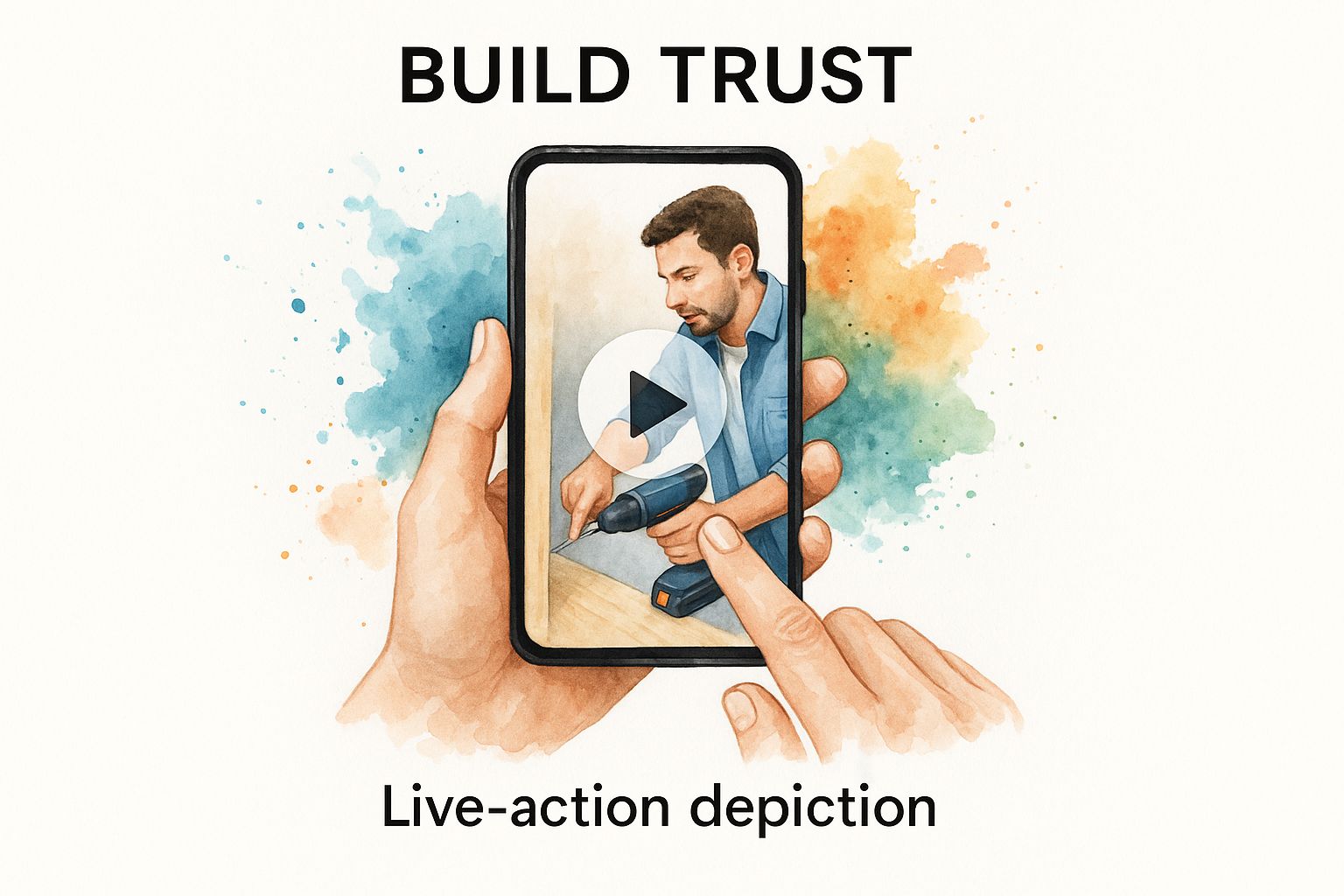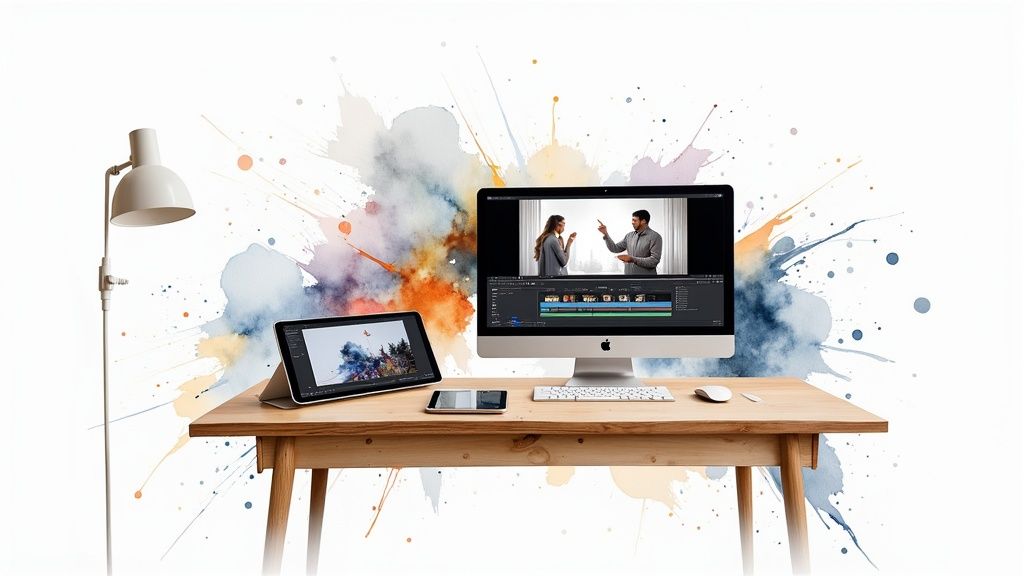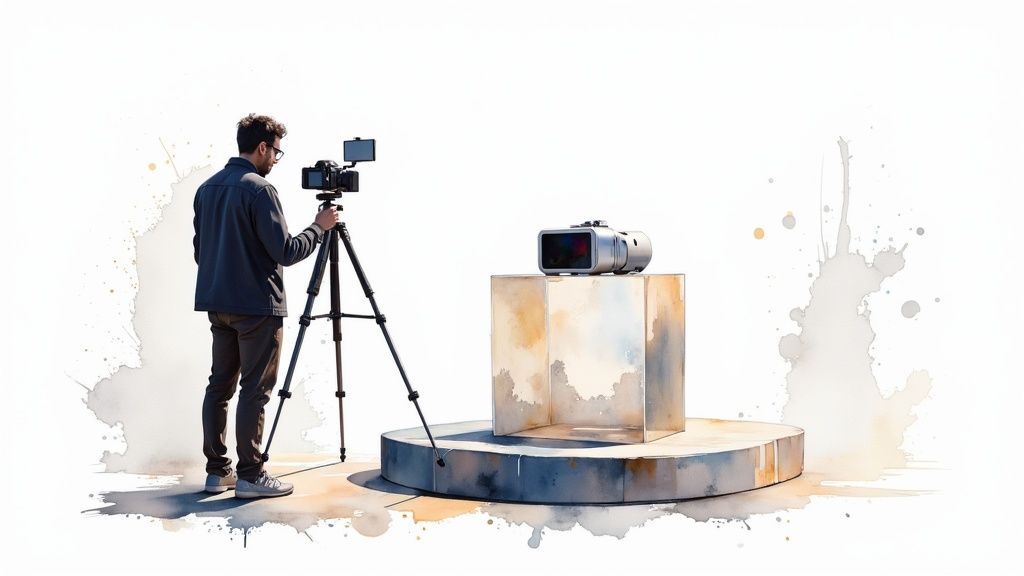Create video product demonstrations that convert. This guide covers proven strategies, key metrics, and best practices to boost sales and engage customers.
In This Article
Subscribe to our newsletter
Video product demonstrations are exactly what they sound like: videos that show your product's value, benefits, and uses in action. But they're so much more than a list of features. A good demo is a powerful sales tool because it helps customers visualize the solution in their own lives, building the trust needed to pull the trigger on a purchase.
Why Showing Your Product in Action Is a Game Changer
In a market this crowded, plain text and static photos just don't cut it anymore. Today’s buyers expect to see a product work before they commit, and this is where video product demonstrations have become absolutely essential.
Think of it like buying a new car. You wouldn't just read the brochure, right? You’d want a test drive to feel how it handles, hear the engine, and experience the features for yourself.
A video demo is that virtual test drive. It closes the gap between seeing a product and truly understanding how it solves a specific problem. By showing your product in a real-world context, you answer questions your potential customers might not even know they have. This simple act of showing, not just telling, is incredibly powerful. In fact, research shows a staggering 94% of customers say watching product videos builds their confidence to buy.
Building Trust Through Visualization
The real magic of a product demo video is its ability to build trust and a sense of psychological ownership. When a prospect watches your product solve a problem they have, they start to imagine themselves getting that same result. It's a critical step in their buying journey.
It takes an abstract concept and makes it a tangible solution. Watching a software demo untangle a confusing workflow, for instance, makes the benefit immediate and obvious in a way a feature list never could. That visual proof is a huge persuader.
The infographic below shows how a video demo guides a customer from just being curious to feeling confident enough to make a purchase.

This really drives home a key point: the path to conversion is paved with clarity and confidence, and nothing delivers that better than showing your product live in action.
More Than a Feature Tour
A truly great demo doesn't just walk through a checklist of features; it tells a story. It positions the product as the hero in the customer's journey, guiding them from a point of frustration to a place of success. This narrative approach makes the information stick and connect on an emotional level.
By focusing on the "before and after" transformation, a video product demonstration shifts a customer's mindset from "What does this do?" to "I need this solution right now."
That mental shift is exactly what you need to speed up the sales cycle. Instead of just listing what your product can do, you're proving its value and demonstrating the real-world impact it will have. This is how you turn passive viewers into engaged buyers who are ready to take the next step.
What Separates a Good Demo from a Great One
Plenty of companies crank out video product demonstrations, but how many of them actually stick? Most fall into the "good" category. They’ll walk you through a product's features, kind of like a visual user manual. It’s informative, sure, but it’s usually forgettable.
A great demo, on the other hand, plays a completely different game. It tells a story.
This is the real difference between a simple feature tour and a sales tool that actually works. A great video doesn't just show off what your product can do. It anchors that functionality to a real customer problem and shows them the light at the end of the tunnel—the transformation.
That’s how you shift a viewer’s thinking from a passive "Huh, what does this do?" to a much more active "I need this in my life, right now." It’s less about the specs and more about the impact.
From Feature Lists to Benefit-Driven Stories
The single most common mistake I see in product demos is a relentless focus on features. A feature is just a part of your product, like "cloud storage" or "one-click integration." A benefit is the real-world win for the customer, like "never losing an important file again" or "slashing hours of mind-numbing data entry."
Great demos are always built around benefits. They kick off with a problem the audience knows all too well—a nagging frustration, a time-sucking inefficiency. Then, they introduce your product as the hero that swoops in to solve that specific pain.
Think of a good demo as a solid documentary about your product. A great demo is its Oscar-winning biopic. It’s the one that’s going to engage and move a much bigger audience.
Framing it this way is just far more compelling because it reflects the customer's own journey. It’s not about showing off a dashboard; it’s about showing a clear path from struggle to success, with your product leading the way.
The Rise of Video as a Primary Tool
The move from stuffy, in-person presentations to video has been a massive shift, especially over the last couple of decades. Once broadband internet became common in the early 2000s, the stage was set. Fast forward to 2023, and it was predicted that a staggering 82% of all internet traffic would be video. That's a huge jump from just 27% in 2012.
What this tells us is that people now expect rich, visual content. And video product demonstrations are perfectly positioned to deliver it. You can dig into more data on video's growth here.
But with this flood of content comes a new challenge. Your viewers have seen it all. To cut through the noise, your video has to do more than just present information—it needs to build a real connection.
Authenticity as the Secret Ingredient
This brings us to the final piece of the puzzle: authenticity. A great demo feels genuine and relatable. Ditch the overly polished corporate-speak and the robotic, scripted tone.
The best videos feel like you're getting a walkthrough from a knowledgeable guide who actually believes in the solution they're showing you. This is what builds trust and makes your message stick. When people sense that authenticity, they're much more likely to believe in your brand and take the next step.
So, what are the core ingredients of a winning demo?
- A Clear Narrative: Frame your video around a simple problem-solution-outcome story.
- Relentless Focus on Benefits: Always connect the dots between what a feature is and what it does for the customer.
- An Authentic Tone: Just talk like a human. Build some genuine rapport.
Nail these elements, and you’ll create something much more powerful than a simple feature showcase. You'll have an asset that truly persuades and converts.
Crafting Your High-Converting Demo Video
So, you're ready to make a demo video that actually gets results? Awesome. Creating a powerful video product demonstration is less about just hitting the record button and more about smart, strategic thinking. Let’s walk through the whole process, from that first spark of an idea to the final, polished video.
First things first: ditch the feature list. A truly high-converting demo doesn’t just list what your product does; it tells a story. It hooks the viewer with a relatable problem, positions your product as the perfect solution, and wraps up with a clear, successful outcome. This narrative approach makes your demo far more memorable and connects on an emotional level.
Planning Your Narrative and Visuals
Before you even glance at a camera, you need a solid plan. A storyboard or even a simple script is your best friend here. It helps you map out the entire story, making sure every single second of your video has a clear purpose.
Next, think about the visual style. What makes the most sense for your product? A slick software platform needs a different approach than a physical product you can hold in your hand. This choice has a huge impact on how viewers connect with what you're showing.
- Screen Recordings: This is your go-to for SaaS products, apps, and anything digital. Use high-quality recording software to get a crisp, clear picture. Don't be afraid to zoom in on key actions to guide the viewer’s eye and keep them focused.
- Live-Action Shots: If you have a physical product, this is a must. Show a real person using it in a real-world setting. It helps your audience picture themselves using the product and builds a ton of trust.
- Animated Explainer: Got a complex service or an idea that’s tough to show visually? Animation is a fantastic tool. It can break down complicated concepts into simple, engaging visuals and inject a little personality into your brand.

Once the plan is locked in, you can get into the technical nitty-gritty. Remember, a polished final product screams credibility. A demo that’s full of glitches and technical hiccups can do the exact opposite, making your whole brand feel unprofessional.
A great demo video is a key piece in the broader puzzle of Conversion Rate Optimization Strategies, designed to maximize sales and leads from your website traffic.
Mastering the Technical Execution
With your story and visual plan ready, it’s time to bring it to life. There are two things that can absolutely make or break your video: audio and pacing. It's funny—people will forgive slightly grainy video, but they will bounce immediately if the audio is terrible.
Seriously, invest in a decent external microphone. Crystal-clear audio means your message lands without any distractions. Try to avoid recording in echoey rooms or anywhere with a lot of background chatter. A clean voiceover is infinitely better than muffled, hard-to-understand audio.
Pacing is just as crucial. You’ve got to keep the energy up to hold your viewer's attention. Don’t spend too much time on any single feature. A good rule of thumb for a product page demo is to keep it between two and five minutes. That’s the sweet spot for showing off value without losing your audience.
Before you hit publish, it’s worth double-checking your work against a list of essential components. Think of it as a pre-flight checklist to make sure you've covered all your bases for a truly effective demo.
Here's a quick table to guide you:
Essential Components for Effective Demo Videos
A checklist of critical elements to include in your video product demonstrations, categorized by production phase.
| Phase | Essential Element | Why It Matters |
|---|---|---|
| Pre-Production | Clear Story Arc | Structures the video around a problem-solution narrative, making it engaging and memorable. |
| Pre-Production | Defined Target Audience | Ensures the language, tone, and benefits shown resonate directly with the ideal customer. |
| Pre-Production | Script or Storyboard | Maps out visuals and dialogue, guaranteeing a focused and concise final product. |
| Production | High-Quality Audio | Bad audio is an instant turn-off. Clear sound keeps viewers engaged and looks professional. |
| Production | Clean Visuals & Good Lighting | Whether screen recording or live-action, visuals must be sharp, bright, and easy to follow. |
| Post-Production | Purposeful Pacing | Keeps the video moving and maintains viewer interest from start to finish. |
| Post-Production | Clear Call-to-Action (CTA) | Tells the viewer exactly what to do next, turning passive viewing into an active conversion. |
Running through these elements will help you avoid the common pitfalls and ensure your final cut is something you can be proud of.
Common Mistakes to Sidestep
Even the best-laid plans can go sideways. Knowing the common traps ahead of time can help you create a pro-level video product demonstration right from the get-go.
Checklist of What to Avoid:
- Using Jargon: Ditch the technical terms and industry acronyms your audience might not know. Always speak your customer's language, focusing on benefits they can actually understand.
- Poor Lighting: Whether it’s live-action footage or you on camera, dim, shadowy lighting just looks amateur. Use natural light whenever you can, or grab a simple lighting kit to make sure your shots are bright and clear.
- Distracting Backgrounds: A cluttered office or a busy background pulls focus away from the star of the show: your product. Go for a clean, simple, or branded background that keeps their eyes where you want them.
- Forgetting the Call-to-Action (CTA): This one is huge. What do you want people to do after watching? Your video must end with a clear, direct CTA. "Start Your Free Trial," "Book a Demo," "Shop Now"—whatever it is, say it loud and clear. This is how you turn a viewer into a customer.
Real-World Examples of Demos Done Right
Theory is great, but there's nothing like seeing it in action. To really bring these ideas to life, let's pull back the curtain on some of the best video product demonstrations from a few brands that are absolutely crushing it.
By breaking down what makes them so effective, you can borrow their winning plays and adapt them for your own product. We'll look at how each brand tackles storytelling, visuals, and audience focus to create a demo that doesn't just show—it sells.
These examples prove there's no single, rigid formula for a killer demo. It all comes down to truly knowing your product's value, understanding what your audience actually needs, and then finding the most powerful way to connect the two.
Slack: The Masterclass in Benefit-Driven Storytelling
Slack's product demos are a masterclass in selling the destination, not the airplane. Instead of marching you through a feature list on a dashboard, their videos tell a relatable story about making work life better.
They almost always kick off with a problem we’ve all felt: a project spiraling into chaos, with conversations scattered across emails and DMs. Then, Slack enters as the hero. You see how channels, threads, and integrations bring a sense of calm and order to the madness. The whole narrative is built around that positive transformation.
Slack’s genius is selling a feeling—the feeling of being organized, in sync, and on top of your game. The software is just the vehicle that gets you there.
This approach makes their video product demonstrations so convincing. You don't just see a piece of software; you see a better way to get things done. You start picturing your own projects running that smoothly, which is a powerful nudge to give it a try.
Dyson: A Visual Spectacle of Engineering
Dyson plays a completely different game, and it’s just as effective. Their products are marvels of complex engineering, and their demos make that complexity both stunning and simple to understand. Using gorgeous CGI and high-end visuals, they literally take you inside the machine.
You're not just watching someone vacuum a rug. You’re seeing the iconic cyclones spin and the physics of the airflow in action. This visual deep-dive accomplishes a few critical things:
- It Builds Credibility: By peeling back the layers and showing the intricate engineering, Dyson instantly justifies its premium price. It communicates quality and innovation without saying a word.
- It Simplifies Complexity: Abstract engineering terms like "cyclonic separation" suddenly become concrete and easy to grasp when you can see them animated.
- It Creates a "Wow" Factor: Let's be honest, the demos are just cool to watch. They make a household appliance feel as exciting and futuristic as a sports car.
Dyson proves that even for a physical product, a video demo can do so much more than a simple live-action shot. It can make the invisible visible and turn heavy engineering into a captivating story that builds massive trust.
HubSpot: The Problem-Solution Narrative for B2B
HubSpot is the undisputed champ of creating content for a specific B2B crowd. Their demos are meticulously crafted to speak directly to the pains and goals of marketing and sales professionals.
They nail the classic problem-solution framework every single time. A HubSpot demo will typically start by calling out a common headache their ideal customer faces, like losing track of leads or fumbling with a messy content calendar.
Then, the video calmly walks you through exactly how the HubSpot platform resolves that specific problem, step-by-step. The focus is always on practical application and measurable results. HubSpot gets that its audience isn't there for flashy effects; they're looking for a dependable tool to make their job easier and more successful.
By staying so laser-focused, HubSpot's demos feel less like a sales pitch and more like a helpful strategy session. This builds authority and positions them as a trusted advisor—a crucial advantage when it comes to closing B2B deals.
You’ve created and published a killer product demo. That’s a huge win, but it’s really only half the battle. Now comes the important part: figuring out if it’s actually working.
To understand the true value of your video product demonstrations, you have to look past the flashy, feel-good numbers. A high view count is great for the ego, but it doesn't tell you much about how your audience is actually behaving.
Did they watch the first ten seconds and bail? Did they skip straight to the end? Or did they lean in, watch intently, click your call-to-action, and move one step closer to becoming a customer? Answering these questions is the only way to justify the time and money you spent and, more importantly, to make even better demos next time.
Moving Beyond Simple View Counts
First things first: we need to stop obsessing over views. Views are a starting point, sure, but they don't tell the whole story. Instead, we need to get serious about tracking the metrics that show how your demo is resonating with potential customers.
Think of it like a retail store. Knowing how many people walked through the door is nice, but it’s far more valuable to know how many people browsed a specific aisle, picked up a product, and actually bought something. The same logic applies to your video analytics.
The real goal isn't just to get people to start watching your product demonstration; it's to get them to stay, understand the value, and take the next step. True success is measured by action, not just attention.
To get this kind of insight, you need to track a few key performance indicators (KPIs) that paint a much clearer picture of your video’s impact.
Here are the essential metrics you should be monitoring:
- Audience Retention Rate: This shows you the percentage of viewers still watching at any given point in your video. Honestly, it’s probably the single most important metric for understanding engagement.
- Click-Through Rate (CTR): This tells you how many people clicked on your call-to-action (CTA) link during or after the video. It’s a direct measure of how motivated your viewers were.
- Conversion Rate: This tracks how many viewers actually completed the goal you set, like signing up for a trial, booking a sales call, or making a purchase. This is where you see the real ROI.
These numbers go way beyond surface-level data. They connect your video's performance directly to tangible business outcomes, giving you the ammo you need to refine your strategy.
Analyzing Audience Retention and Drop-Off Points
Think of your video’s audience retention graph as a roadmap of your viewer’s attention span. It shows you exactly where their interest is highest and, more critically, where it falls off a cliff. A healthy graph will show a slow, gentle decline, meaning most people are sticking around.
But if you see a sudden, sharp drop at a specific point? That’s a massive red flag. It tells you something in that section—maybe a confusing explanation, a boring feature walkthrough, or even a technical glitch—is causing people to lose interest and click away.
By pinpointing these drop-off points, you can diagnose what’s wrong with your content. Maybe your intro is too slow to get to the good stuff. Maybe you dive into technical jargon way too early. This data gives you direct, actionable feedback for your next video, helping you craft a story that holds attention from start to finish.
Tracking Intent with Click-Through and Conversion Rates
While retention tells you if your demo is engaging, click-through and conversion rates tell you if it's having an impact. Your click-through rate (CTR) on the video's call-to-action is a powerful signal of just how persuasive your demo was. A high CTR means you successfully lit a fire under your viewers and made them want to learn more.
But the ultimate measure of success? That’s the conversion rate. This is the metric that ties your video directly to revenue. It answers the most important question of all: "Did this video help turn a viewer into a customer?" To track this, you’ll need to set up goals in your analytics platform to monitor things like sign-ups or purchases coming from your video's landing page.
For B2B companies, a high conversion rate on a "Book a Demo" CTA is gold. It means your video is generating highly qualified leads and potentially shortening your sales cycle. According to one survey, the average demo close rate for many B2B companies can land anywhere from 20% to 50%. A truly compelling video can push that number toward the higher end, giving your revenue a direct boost.
When you combine these metrics, you get the full picture. High retention shows you’re making content people want to watch. A strong CTR proves you’re inspiring action. And a solid conversion rate confirms that your video product demonstrations are a seriously valuable asset for your bottom line.
Making High-Quality Demo Creation Easier

The idea of producing a steady stream of professional video product demonstrations can feel like a huge ask. For teams without a dedicated video guru or a Hollywood-sized budget, it’s easy to get stuck.
The planning, scripting, recording, and editing can seem like a mountain to climb, often leading to total paralysis. But here’s the thing: that barrier to entry has never been lower.
Modern tools are completely changing the game. Think of it this way: you don't need to be a professional web developer to build a beautiful website anymore, thanks to platforms like Squarespace. It's the same story with video. You don’t need to be a seasoned editor to create polished, effective product demos.
From Manual Labor to Automated Workflows
The real shift is moving away from all the manual, time-sucking tasks and toward more automated, guided processes.
Instead of wrestling with complex editing software, your team can now use tools that do the heavy lifting for you. This frees you up to focus on the story and the message—not the technical headaches of production.
Aeon, for example, helps teams create fantastic videos at scale by transforming existing content into engaging video formats with almost no friction. This approach tears down the old walls that made video creation so difficult.
What makes this possible? A few key features:
- AI-Assisted Editing: Imagine tools that automatically trim awkward pauses, suggest where to make cuts, and even generate captions. This shaves countless hours off post-production.
- Pre-Built Templates: You can start with a professionally designed template that keeps your branding consistent and your look polished, all without needing a graphic designer.
- Easy Collaboration: Cloud-based platforms let team members comment, review, and approve videos in one central hub. No more digging through confusing email chains.
By removing the technical roadblocks, these tools empower subject matter experts—the people who know the product best—to become the creators. This leads to more authentic and impactful video product demonstrations.
Making Great Demos an Achievable Goal
What all this means is that producing high-quality demos is no longer a luxury reserved for massive corporations. It’s a completely achievable goal for teams of any size.
By adopting the right platform, you can go from simply understanding what makes a great demo to consistently creating them. Efficiently. This doesn't just save time and money; it makes you more agile. You can spin up targeted videos for different audiences and campaigns without getting bogged down in a massive project.
To keep up with broader content marketing trends that can boost your video strategy, it's worth checking out resources like the Contentide blog. Ultimately, the right tools make video a sustainable, ongoing part of your marketing—not just a one-off headache.
Frequently Asked Questions About Product Demos
Even with the best game plan, questions always come up when you start making video product demonstrations. Getting straight answers to these common hang-ups can sharpen your strategy, save a ton of time, and ultimately, get you much better results.
Think of this as your quick-reference guide for dodging the usual hurdles. We’ll cover the practical details that trip people up, from video length to the gear you actually need.
How Long Should My Product Demo Video Be?
The only honest answer? It depends. The perfect length is completely tied to how complex your product is and where your audience is watching. There’s no single magic number, but there are some solid rules of thumb.
- For social media: Keep it short and punchy. Aim for 60-90 seconds. The goal is to grab attention fast and make people curious.
- For product or landing pages: The sweet spot is 2-5 minutes. This gives you enough runway to hit the key benefits and tell a solid story without losing your audience.
- For complex B2B software: For an audience that’s already deep in the evaluation process, a more detailed 5-10 minute demo can be a game-changer. They’re looking for specifics, and this format gives you the space to deliver.
The most reliable way to find your perfect length is to dive into your analytics. The data never lies—pay close attention to audience retention graphs to see exactly where viewers start to drop off and adjust accordingly.
This is how you stop guessing and start making decisions based on what your audience actually does.
Do I Need Expensive Equipment to Make a Good Demo?
Not anymore. While pro-level gear is always a nice-to-have, it’s far from a must-have for creating a demo that works. A modern smartphone can capture surprisingly good video, but there's one area where you absolutely cannot cut corners.
Your audio quality is non-negotiable. People will forgive video that’s a little grainy, but they will click away in a heartbeat if the sound is muffled, echoey, or hard to follow. A decent, affordable external microphone is one of the smartest investments you can make.
Beyond that, just focus on the basics: good, natural lighting and a high-quality screen recording tool for software demos. The clarity of your message and the power of your script will always matter more than cinematic perfection.
What Is the Biggest Mistake to Avoid?
The single most common trap is focusing on features instead of benefits. It’s so easy to get wrapped up in all the cool things your product can do and just list them off. But your audience is always, always thinking, "What's in it for me?"
Don't just show a feature; wrap it in a story of transformation.
- Start with a real pain point your customer wrestles with every day.
- Introduce your feature as the hero that solves that specific problem.
- End by showing the better outcome—the "after" state where their work is easier, faster, or more successful because of you.
Always answer that silent question: "How does this make my life better?" When you consistently tie every feature back to a real-world benefit, your video product demonstrations stop being simple walkthroughs and start becoming powerful conversion tools.
Ready to create stunning demo videos without the technical headaches? Aeon helps you transform your content into professional-quality videos at scale. See how it works at https://www.project-aeon.com.


.jpg)